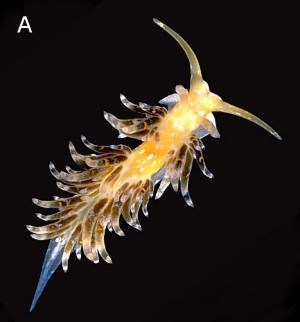
Austraeolis ornata
(Angas, 1864)
Order: NUDIBRANCHIA
Suborder: AEOLIDINA
Family: Glaucidae
DISTRIBUTION
southern Australia
PHOTO
A, Roches' Beach, Hobart, Sthn Tasmania, Feb 1984, intertidal, 12mm long.
B, Mouth of Don River, Devonport, Nthn Tasmania, Feb 1984, 7m, 18mm long. C, Gleason's Landing, Yorke Peninsula, South Australia, Feb 1985, intertidal, 23mm long.
D, E, Five Dock Point, Drummoyne, Sydney Harbour, July 1982, intertidal, 56mm long. PHOTOS: Bill Rudman.
This is probably the most common intertidal and shallow sublittoral aeolid in southern Australian waters. It grows at least to 60mm in length and ranges in colour from a pale translucent yellow to an intense bright orange. There are usually white patches and posts on the body often bluish or iridescent. The rhinophores has some prominent folds or ridges and are usually tipped with white. The ceratal digestive gland ranges in colour from a pale yellow to a dark brown. In smaller cerata, especially on smaller animals, there is a brilliant colour pattern on the ceratal wall consisting of a complete white subapical band and a bright yellow band which is only on the outer face of the ceras. There can also be a similar half-band of turquoise specks above and beow the yellow band, and scattered all over the cerata are iridescent blusih white specks. Often hovere, especially in larger animals these colours are lost except in the smallest cerata. The photos on this page illustrate these colour variations.
Despite being common, little is known about its biology except that it has small white eggs from which planktotrophic larvae hatch. As a glaucid we might assume that it feeds on hydroids but I have never actually found it on hydroids and captive animals are quite voracious feeders on carrion, other aeolids etc, suggesting a feeding behaviour similar to that reported for Hermissenda crassicornis. I have found it feeding on live Aeolidiella foulisi at least three times including the 56mm animal [PHOTO D] eating a 21mm long Aeolidiella. Ian Loch watched one in an aquarium attacking a jelly fish. Ian Anderson [see messages below] reports it feeding on the anemone Aiptasia.
When disturbed, larger animals in particular, will bristle their cerata, and shake them about.
Reference:
• Angas, G.F. (1864) Description d'espèces nouvelles appartenant à plusieurs genres de Mollusques Nudibranches des environs de Port-Jackson (Nouvelles-Galles du Sud), accompagnée de dessins faits d'après nature. Journal de Conchyliologie, 12: 43-70.
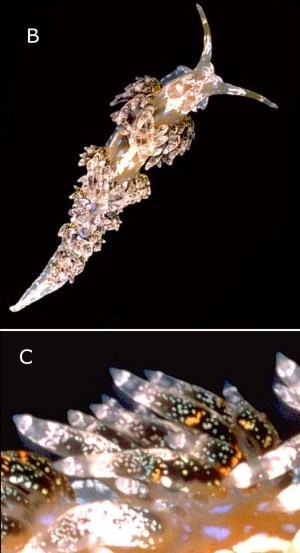
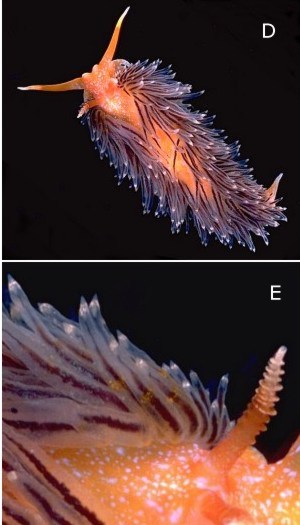
Rudman, W.B., 2000 (June 8) Austraeolis ornata (Angas, 1864). [In] Sea Slug Forum. Australian Museum, Sydney. Available from http://www.seaslugforum.net/find/austorna
Related messages
Austraeolis ornata from South Australia
April 13, 2010
From: Erinn Fagan-Jeffries

Hi!
Any help with ID for this little critter would be much appreciated :)
Locality: Marino Rocks, intertidal, South Australia, Intertidal Beach, 12 April 2010, intertidal rocky beach, under rock. Length: 10 mm. Photographer: Erinn.
Cheers,
Erinn
erinn.fagan-jeffries@student.adelaide.edu.au
Fagan-Jeffries, E. P., 2010 (Apr 13) Austraeolis ornata from South Australia. [Message in] Sea Slug Forum. Australian Museum, Sydney. Available from http://www.seaslugforum.net/find/23478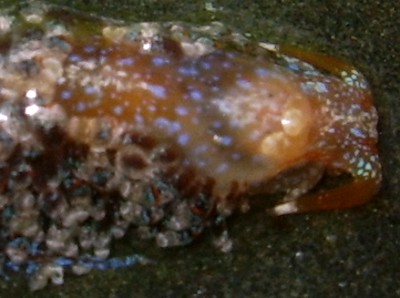
Dear Erinn,
This aeolid nudibranch doesn't look its best stranded on the sand but it is almost certainly Austraeolis ornata. Have a look at other messages of it on the Forum, which are attached to the species' Fact Sheet, for a better view.
Best wishes,
Bill Rudman
Re: Austraeolis ornata from Port Stephens, eastern
April 14, 2008
From: Gary Cobb
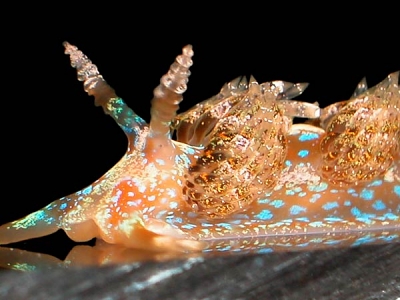
Concerning message #20928:
Hi Bill and everyone!
After reading the Forum this morning I thought I might share with you the Austraeolis ornata found here on the Sunshine Coast, sthrn Queensland Australia. All the animals have been found intertidally. Alexandra headland and Caloundra boat ramp are the main search areas.
The animals here seem to have larger blue spots.
PS. I have updated Nudibranch.com.au there is a search facility, find Nudibranchs by colour or name, and a form to get IDs. Just trying to help out the curious. Enjoy!
Locality: Caloundra Headland, Mooloolaba, 100mm, Queensland, Australia, Pacific Ocean, 31 July 2005, Intertidal. Length: 6-32mm. Photographer: Gary Cobb.
Cheers
Gary
gary@nudibranch.com.au
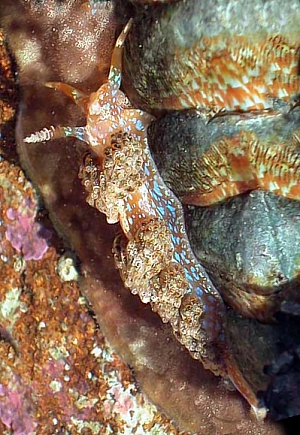
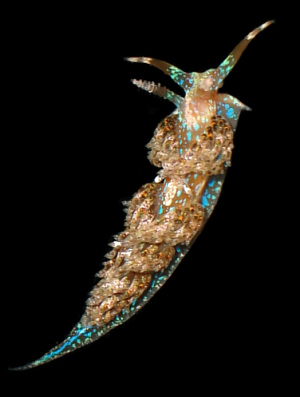
Thanks Gary,
Best wishes,
Bill Rudman
Austraeolis ornata from Port Stephens, eastern Australia
April 11, 2008
From: Leanne & David Atkinson
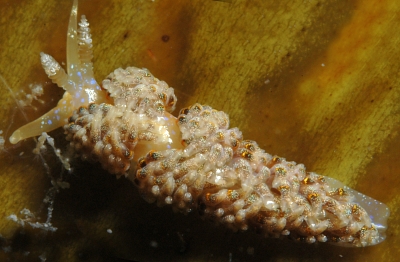
Dear Bill,
We found what we think is an Austraeolis ornata at Fly Point in 8 meters on a piece of kelp. These photos show the scattered iridescent bluish white specks, the yellow band and half band of turquoise on the cerata that you mention on the fact sheet. It also shows the ridges on the rhinophores. We thought they might be of interest to you since you didn't have many photos of Austraeolis ornata and they seem to vary greatly in colour. We thought these might illustrate one of the colour forms well for you and you could confirm the identity for us. Thank you as always for the wonderful work that you do on the forum..
Locality: Fly Point Marine Sanctuary, Port Stephens, 8 meters, New South Wales, Australia, Pacific, 6 October 2007, Sandy bottom, Kelp, algae, scattered sponges and winter slime. Length: 30mm approximately. Photographer: Leanne & David Atkinson.
Best wishes,
Leanne & David Atkinson
atk@hunterlink.net.au
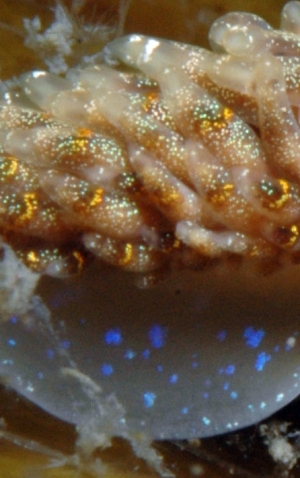
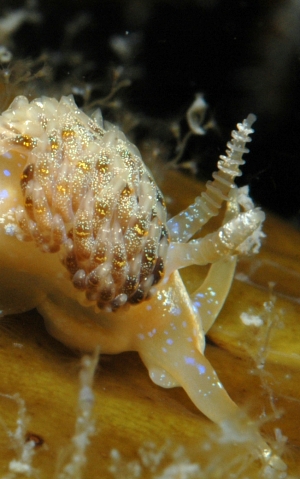
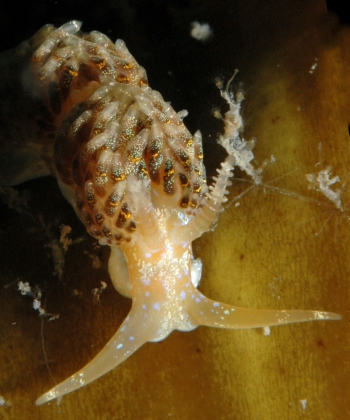
Dear Leanne & David,
Thanks for these nice photos of Austraeolis ornata. It's really what you could call a 'surprise package'. With the naked eye it just looks like a dull brownish aeolid crawling along but shine a bright light on it or magnify it with a camera or a binocular microscope and it comes to life with brilliant blue and opalescent white speckles on the body and foot, and the orange and yellow markings on the cerata.
Brown algae, such as kelp, may seem a strange place for hydroid eaters to be found but as I am sure you are aware their flat surfaces make them an ideal place for hydroids to thrive. In your photos you can see the little thread like lines running across the kelp. These are the root-like tubes of tissue which link the hydroid stalks together.
Best wishes,
Bill Rudman
Austraeolis ornata found in nthn NSW, Australia
June 13, 2006
From: Ruth Owler
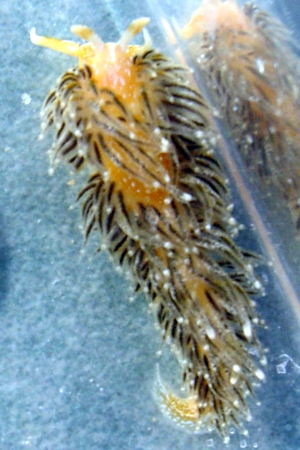
Hi,
I am studying an intertidal area at Lennox Heads, Northern NSW. I came across this sea slug in one of the rock pools at low tide. The area that I study is completely submerged at high tides and can get down to less than 0.1m tides at low. I was wondering if it is possible to get Austraeolis ornata as far north. Also if you are able to tell me that this is Austraeolis ornata. I found a second identical one the day before but it was only approx 9 mm in length.
Locality: Lennox Heads "Moat", 0.5 m, Lennox Heads, Northern New South Wales, Australia.
Regards
Ruth
ruthowler@westnet.com.au
Owler, R., 2006 (Jun 13) Austraeolis ornata found in nthn NSW, Australia. [Message in] Sea Slug Forum. Australian Museum, Sydney. Available from http://www.seaslugforum.net/find/16861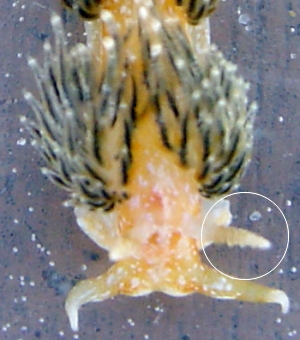
Dear Ruth,
Yes this is Austraeolis ornata. Although it is a basically a temperate Australian species it seems to extend up into southern Queensland,a nd quite a way up the Western Australian coastline as well. It has quite a distinctive colour pattern, and the way the cerata are arranged into distinct clusters is a are useful identification feature. Also distinctive are the ridges on the rhinophores which I have ringed in the close-up.
Best wishes,
Bill Rudman
Austraeolis ornata from Nelson Bay
October 20, 2003
From: Dave Harasti
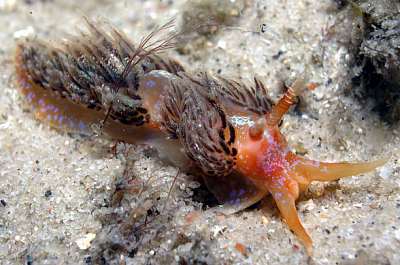
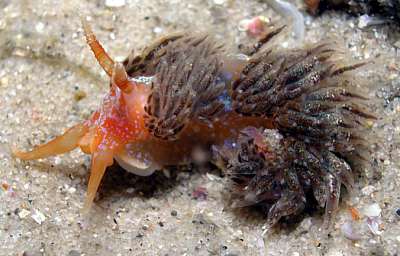
Hi Bill,
I found this species on a night dive at Fly Point, Port Stephens, NSW - Australia on Oct 11 2003. Water temp was 18 degrees and depth was 12 metres. I believe it is Austraeolis ornata, is this correct?
Regards,
Dave Harasti
diving@webone.com.au
Harasti, D., 2003 (Oct 20) Austraeolis ornata from Nelson Bay. [Message in] Sea Slug Forum. Australian Museum, Sydney. Available from http://www.seaslugforum.net/find/11212Yes Dave,
This Austraeolis ornata. It never seems to be present in large numbers but one or two animals can usually be found on rocky shores, from the inter-tidal to at least 15m, all around the southern half of Australia
Best wishes
Bill Rudman
Austraeolis ornata and eggs
August 29, 2003
From: Rachel Przeslawski
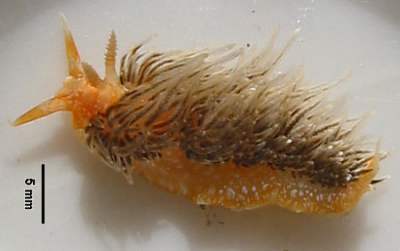
Hi Bill,
I noticed you don't have any photos of the egg masses of Austraeolis ornata yet. I found this fairly large adult just finishing laying an egg
mass at Wollongong, NSW. When the adult was touched or disturbed, it ruffled and expanded its cerata as well as contorting/ spasming its body ... quite an impressive display for a little slug!
Rachel
rachelp@uow.edu.au
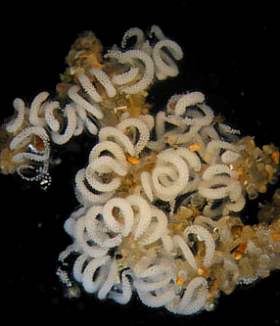
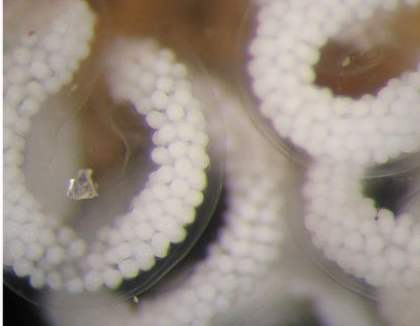
Thanks Rachel,
It's good to get the egg mass photo. Bob Rose (1985) reported the larvae to be planktotrophic. Your observation on it waving its cerata when disturbed, reminds me of Marina's recent message on defensive behaviour in Aeolidiella alderi.
Best wishes,
Bill Rudman
Re: Austraeolis ornata from Sydney
November 28, 2001
From: Mairi Prisk
Dear Bill,
Thanks for the ID, it's great to be able to come here and find this info! I have many sea hares and small green slugs (2-3mm, light green, sorry no photos yet). The Austraeolis ornata doesn't seem to diminish the population any. I guess he could be snacking on the leftover frozen mysis and brine shrimp from the seahorses' meals. I have had hydroids and Aiptasia in the tank, and after I found this guy the hydroids went and the Aiptasia reduced significantly. I reckon it's a good bet he's responsible.
I don't see much of the Austraeolis, but today I found him in a little cave and he is about twice the size from last week, and his furry fronds are really thickening. I don't know much about these groovy beasts but I really love my slugs!
Thanks again for providing such a valuable service. I will be back with more photos of my other slimy friends soon!
Mairi
mairi_p@telstra.com
Prisk, M., 2001 (Nov 28) Re: Austraeolis ornata from Sydney. [Message in] Sea Slug Forum. Australian Museum, Sydney. Available from http://www.seaslugforum.net/find/5748Dear Mairi,
I see in Ian Anderson's message that he had Austraeolis eating Aiptasia so perhaps this is an Australian answer to Aiptasia infestations. Concernings its "furry fronds". They are called cerata. Have a look at the Cerata page for some information on these stuctures. If you click on some of the buttons at the top of the page [General Topics, Species List, etc] yo will find quite a lot of background information on Sea Slugs.
Best wishes,
Bill Rudman
Austraeolis ornata from Sydney
November 26, 2001
From: Mairi Prisk
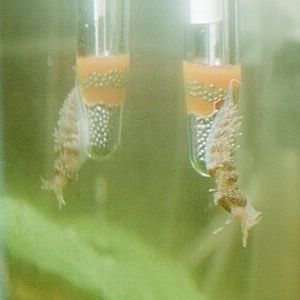
I have a seahorse tank which I often replenish with water from Sydney's Northern Beaches areas, in particular Mona Vale and Palm Beach [New South Wales, Australia]. I found this gorgeous beast a few weeks ago. It was about 1cm when I first saw it, now it is about 1 inch! I have a regular population of sea hares (pink and dark brown) as well.
I get the water from tidal pools inhabited with sea grasses, lots of dragonets and other small fish fry, cleaner shrimp, snails and starfish. Usually I go as the tide has recently receded, so I can search for hermits as shrimp. The pools are sandy and have constant flow, so the water for the horses is very fresh.
I appreciate your help!
Thanks!
Mairi Prisk
mairi_p@telstra.com
Prisk, M., 2001 (Nov 26) Austraeolis ornata from Sydney. [Message in] Sea Slug Forum. Australian Museum, Sydney. Available from http://www.seaslugforum.net/find/5726Dear Mairi,
Your animal is Austraeolis ornata. Have a look at the top of this page, and at the messages below yours, for more information. It is quite common in intertidal pools around Sydney, and in fact around much of temperate Australia. Although it is a hydroid feeder, it also seems to be quite catholic in its food requirements, having been observed eating carrion and at times other nudibranchs. If it has doubled in size in your aquaria, it has obviously found a satisfactory source of food.
best wishes,
Bill Rudman
Re: Aiptasia & Austraeolis ornata
June 12, 2000
From: Ian Anderson
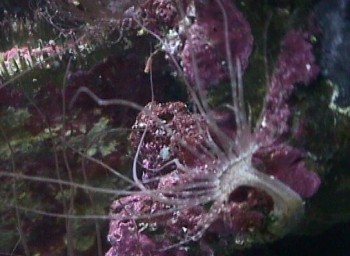
Dear Dr Rudman,
Thank you for your reply. It is with some concern that I read your email regarding Aiptasia sp becoming a pest in Australian waters. I have collected Aiptasia sp at Point Peron (40 km south of Perth) and in the lower reaches of the Swan River, not knowing that this beast is an introduced organism. All of this being part of my university project at Underwater World, in regard to finding an Australian predator for their Aiptasia sp problem. We found Austraeolis ornata on colonies of Aiptasia sp in the Swan River and came to the assumption that A. ornata predates on this hydroid, therefore, a university project was born. We have also seen the same anemone at other locations around Perth. I have attached some photos of the anemone.
The discharge water at Underwater world is not sterilized therefore one could assume that cells from Aiptasia sp would be discharged into the open ocean and could quite possibly be colonizing on the sea wall next to the complex. We have searched extensively for Spurilla australis and S. major with no luck.
Regards
Ian Anderson.
ianderson@vtown.com.au
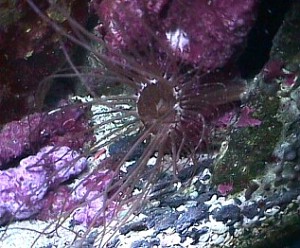
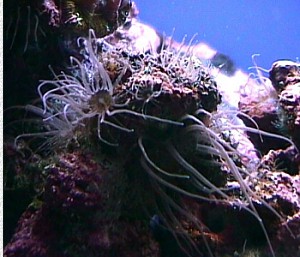
Dear Ian,
I guess the first question is how did you identify the anemone as Aiptasia? I am not an expert on anemones but clearly that is the first thing that needs checking.
Concerning the nudibranchs. Are you sure you have Austraeolis ornata? I haven't ever seen it on anemones. That doesn't mean it never does, but it does raise the possibility that you have a species of Aeolidiella which would be better for you because many species of that genus have direct developing eggs (no larval stage) or lecithotrophic larvae (with short veliger stage) so you could breed up populations of the aeolid in aquaria.
If you could take a few photos it would also give me a chance to check the identity of the aeolid. And can someone with more knowledge of Aiptasia let us know whether they recognise the animal in these photos.
Best wishes,
Bill Rudman.
Aiptasia and Austraeolis ornata
June 10, 2000
From: Ian Anderson
Dear Dr Rudman,
I am currently studying 3rd year marine science at Murdoch University, Perth, Western Australia. One of my units is an industry practicum involving the feeding habits of Aeolid nudibranchs. This is in conjunction with Underwater World (a commercial aquarium) where they have a problem with the "weed" anemone Aiptasia sp. This anemone reproduces via pedal laceration and can become a plague in aquariums under controlled conditions. I currently have tanks containing Aiptasia sp and Austraeolis ornata which are being monitored to understand the feeding habits of A. ornata. It looks like the nudibranch will graze on very small Aiptasia sp but not the larger of the species, therefore it will keep populations in check, but not completely eliminate the anemone.
We are basing this experiment on the Caribbean Aeolid Berghia verrucicornis which predates solely on Aiptasia sp and is used as a control in aquaria.
There is little information on A. ornata or any of the Australian aeolid species that I can find in relation to this subject of predation. If you have any information that I could source or any ideas yourself, I would greatly appreciate this information.
Yours Sincerely
Ian Anderson.
ianderson@vtown.com.au
Ian Anderson, I., 2000 (Jun 10) Aiptasia and Austraeolis ornata. [Message in] Sea Slug Forum. Australian Museum, Sydney. Available from http://www.seaslugforum.net/find/2545Dear Ian,
I am interested to hear of Aiptasia causing problems in an Australian aquarium system. I didn't realise it is in this part of the world. Do Underwater World sterilise their sea water before discharging it or are they letting Aiptasia out into the marine environment?
There is quite a correspondence on Aiptasia control on the Berghia verrucicornis Page in the Forum. I have prepared a page on Austraeolis ornata on the Forum but I'm afraid we don't know much about its feeding habits. It belongs to a family (Glaucidae) which are on the whole hydroid feeders, but there are some species which have a much more catholic diet. Hermissenda crassicornis from California is a good example. I don't know of any published information on the feeding habits of Austraeolis, but in aquaria it will eat bits of carrion, anemones, other aeolids etc and Ian Loch once observed one desperately trying to eat a jellyfish. So even though it doesn't belong to the family Aeolidiidae, which is best known for eating anemones, it's not particularly surprising to hear that you have observed it feeding on anemones as well.
If you really want to try an anemone-eater see if you can find Spurilla australis. It and its relatives feed exclusively on sea anemones. Another species in Western Australia is Spurilla major.
Hope this is of some use. Please let me know if you know anything about the status of Aiptasia in the wild in Western Australia. For all I know it might be widely spread, but if not, its presence is quite worrying.
Best wishes,
Bill Rudman.
